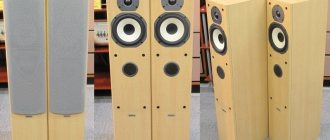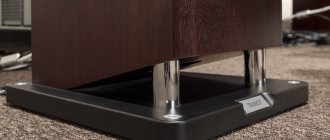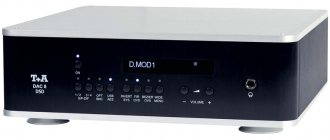Just don’t think that I laid all my cards on the table right in the title and stated the absolute ideality of the speakers being tested. In fact, this is an allusion to the classic Western by John Sturges, which, by the way, was nominated for an Oscar at one time for its musical design.
Well, Tannoy has updated its highly popular Mercury workhorse family. The last, sixth generation lasted on the market for more than ten years, which in itself already says a lot. Well, if so, the more interesting it will be to explore the introduced innovations.
Price limits
The only floor-standing speakers in the series with an index of 7.4 were chosen for testing. Mercury is the most affordable series in the line of the legendary (and this is not a marketing cliche) British brand. And I must say, the acoustics look extremely solid for their category. The vinyl covering of the new series has become more contrasting and detailed, so you can distinguish it from veneer only by almost pressing your nose into the column.
The facades of the “sevens” are noticeably wider than the front panels of the previous generation Mercury. The quality of finishing is five plus
Possible design options: walnut, light or dark oak. The bodies, just under a meter high, rest on plastic podiums with spikes, the bass reflex ports are brought to the rear, and each body is armed with a pair of pipes of relatively small diameter. Terminals that allow bi-wiring connections are gold-plated. The theme of precious metals is continued by the internal wiring - it is made of silver-plated oxygen-free copper wire.
According to official information, the main goal of developing new Mercury cabinets was to improve sound neutrality and combat resonances. The tasks are, of course, obvious, but within this price segment it is quite difficult to implement them at any serious level.
7" drivers are rigidly fixed with six screws
However, Tannoy engineers clearly took a non-formal approach to the problem; for example, in critical areas of the design, such as the contact areas between the speakers and the body and the crossover mounting points, they use a material made using proprietary DMT (Differential Materials Technology). It allows you to minimize distortion and effectively absorb vibration when connecting parts made of materials of different hardness. For the same purpose, the mid/bass drivers are now mounted not with four, but with six screws, and additional spacers are installed in the housing.
The speakers themselves have increased in size to seven inches; their diffusers are not metal, as it might seem at first glance, but cellulose with a proprietary multi-layer coating. The tweeter domes with a diameter of 1.1 inches, unlike the speakers of the previous generation, are also not made of aluminum: they are made of polyester with a damping nitrourethane coating, loaded on a wide flange with a complex surface shape and armed with powerful neodymium magnets. By the way, judging by the factory specifications, the tweeter is capable of reproducing sound (more precisely, ultrasound) up to 32 kHz.
The tweeter dome is made of polyester, and the midbass driver cones are made of multi-layer coated cellulose
The drivers are arranged according to the classic D'Appolito scheme, the signal for the high-frequency component is formed by a third-order filter, and for the midbass - by a second-order filter, the crossover frequency is 2.4 kHz.
I used the Denon AVR-X6200W receiver as the main test source, although for greater purity of the experiment I listened to several tracks performed by the Denon 2500 series stereo set, which I have already talked about.
Acoustic systems Tannoy Mercury 7.4
I wonder what improvements Tannoy specialists managed to make during the transition from the most affordable and popular Mercury Vi series to the new, seventh generation? The answer to this question will be given to us by older systems in the updated model range - floor-standing Mercury 7.4.
And change is really overdue - Tannoy’s most popular Vi series has delighted not-so-wealthy music lovers for the past two decades. And, as the manufacturer claims, the recently launched seventh series, while remaining in the same entry-level price segment, represents a completely different engineering ideology.
The design with vinyl film has its own highlight - the contrasting highlighting of the ribs of the body, which gives the impression that the body is covered with veneer.
Looking at the Mercury 7.4 floor-standing systems, it is easy to list what they adopted from the previous series: spread-out plastic supports, a bass reflex port located on the rear wall, similar terminals for bi-wiring and, if you believe the technical description, internal wiring made of oxygen-free silver-plated copper ( by the way, a rarity in entry-level models). But everything else can already be considered innovation.
The front panels of the cases have noticeably expanded, the proportions have changed, and by combining materials of different densities, the resonant-acoustic properties have improved. The finishing looks interesting. The design with vinyl film has its own highlight - the contrasting highlighting of the ribs of the body, thanks to which, even when viewed closely, one gets the impression that the body is covered with veneer.
Mid-bass drivers with “seamless” diffusers made of a proprietary fiber material are distinguished by increased efficiency.
All drivers installed using D'Appolito's proven scheme are new in Mercury 7.4. The tweeter with a neodymium magnet has replaced the narrow bell with a wide concave flange, and the magnesium-aluminum dome with a soft 28 mm, made of polyester with a nitrourethane coating. Midbass drivers with “seamless” diffusers made of a proprietary fiber material (looks like aluminum, but feels like paper) are distinguished by increased efficiency. Their caliber is increased to 18 cm, the magnets are strengthened, and a suspension is used that is designed for large displacements of the moving system. Finally, if in the sixth generation of Mercury the band for the midrange and high-frequency heads was divided by fourth-order Linkwitz-Riley filters, now the range below 2400 Hz is cut off by a second-order crossover, and above - by a third.
Sound... This is where the fun begins. Tannoy Mercury is loved for its spatial accuracy, tonal accuracy and detail - qualities that are rare for this price category. In the “sevens” the priorities are somewhat different. While maintaining excellent spatial characteristics, they dramatically improved in another quality - overall dynamics. They delight with a free, “big” sound, in which there is not even a hint of any compression or limitation. If you evaluate the tonal balance, then you can also feel a different school here. You can hear velvety shades in the sound signature and, perhaps, some may not find it too bright. But certainly not “dark”! The lower register does not put pressure on the middle register; in the transitional bass/midrange range, thoroughbred articulation is felt. And the most meaningful musical information, the middle band, is played openly and soulfully. This is precisely why acoustics surprise and captivate from the very first seconds. Among inexpensive systems, they set new standards for expressiveness, harmony and sound integrity. What has been said probably sounds pretentious, but there is no other way to formulate it.
Now - about the particulars. The dynamics, alas, are not luxurious across the entire range. In the upper register it is slightly compressed, so it is advisable to select a bright path, with emphasized delivery of high frequencies. The new Mercurys are able to moderate the degree of intrusiveness of the HF of such equipment and at the same time are guaranteed to preserve detail. I would also without hesitation consider the ability to read a subtle microdynamic pattern to be one of the strengths of the systems.
They delight you with a free, “big” sound, in which there is not even a hint of any compression or limitation.
The middle register, judging strictly, is not entirely neutral - it is slightly accentuated in the region of 700 - 1000 Hz. A narrow high band somewhere around 4 - 5 kHz is also slightly highlighted. If these speakers are placed in a loud room without absorbing surfaces, a comfortable timbral balance may not be achieved; in quiet rooms the Mercury 7.4 will sound incomparably better.
Fast, intelligible bass without excessive boominess and “fat” on extended components indicates that the systems are completely subordinate to the amplifier. The “lows” are tangible, and at a high enough volume they create a pleasant “punch” that you feel throughout your chest. However, the acoustics do not go into the very depths of the bass. I don’t mean the “seismic” effects characteristic of cinema soundtracks, but the infrabass of a musical kind, which adds fullness to the sound of a jazz “kick drum” and makes the concert hall tremble from a single blow to a large orchestral drum... However, all this is the task of the subwoofer, and in The new line also has such a unit.
They set new standards for expressiveness, harmony and sound integrity.
The main feature of the Mercury 7.4 is that they provide much more information to the ear than other budget systems. Probably because this time the developers relied not so much on the breadth of the frequency range and super-linearity, but on dynamics and speed, i.e. to what allows you to convey the drive and emotional essence of the music.
Tannoy Mercury 7.4
Manufacturer: Music Group Innovation SC Ltd (Scotland)
www.tannoy.com
Configuration: 3 emitters, 2 bands || Acoustic design: bass reflex || Frequency range: 32 - 32000 Hz || Sensitivity: 93 dB (2.83 V/1 m) || Resistance: 8 Ohm || Crossover frequency: 2400 Hz || Recommended amplifier power: 20 - 150 W || Input power nom/peak: 75/300 W || Finish: Vinyl || Dimensions with supports: 314.3 x 955 x 308 mm || Weight: 15 kg || Price per pair: 79,990 rub.
COMPONENTS
- Sources: Denon DCD-2020AE CD player
- laptop Apple MacBook Air A1465
- digital Blue Dual Shield USB 2.0 AB
MUSIC
- The Manhattan Transfer, "Vocalese". Atlantic Recording Corporation, 1985
- Pink Floyd, "Dark Side of the Moon". EMI, 2003
- Creedence Clearwater Revival, "Chronicle". Fantasy Records, 1976
- King Crimson, "Larks Tongues in Aspic". Virgin EG Records, 1970
- Tracy Chapman, Electra/Asylum Records, 1988
- Nikolai Rimsky-Korsakov, “Scheherazada”, “Capriccio Eapagnol Mackerras”. London Symphony Orchestra. Telarc, 1990
share
Tags: DenonInAkustikTannoy
In the silence of the office
We study
As noted above, all three pairs of speaker systems are made in housings of approximately the same volume. In the class of bookshelf acoustic models, such speakers can be called mid-size. Only the DALI Zensor 3 is slightly larger than the other two participants. But they are not the heaviest - here the Wharfedale Diamond 11.1 holds the palm. In Tannoy Mercury 7.2 and DALI Zensor 3, the bass reflex port is located on the rear wall of the case, which must be taken into account when choosing a place to install the speakers - it is better not to move them too close to the wall.
In the Wharfedale Diamond 11.1, the bass reflex port radiates downward, and therefore the speakers rest on a special plate that provides the clearance with the installation surface necessary for normal operation of the port. The bodies of all participants are made of MDF and covered with decorative vinyl film, skillfully imitating the matte veneer of natural wood. The front panels of the Wharfedale Diamond 11.1 and DALI Zensor 3 are decorated with black piano lacquer, which gives the speakers a certain sophistication. All three models are equipped with protective grills made of acoustically transparent fabric on a plastic frame, and the Wharfedale Diamond 11.1 grills are equipped with magnetic fastenings. This model also stands out in terms of the shape of the cases - while competitors' cases have the usual rectangular shape, the Wharfedale Diamond 11.1 is made to taper in depth, which allows you to effectively combat internal cabinet resonances and standing waves.
The largest midrange/bass drivers are used in the DALI Zensor 3. The diffusers with a diameter of 178 mm are made of DALI proprietary material, which is a mixture of paper pulp and wood fibers and has a characteristic copper-red hue. The high-frequency range here is entrusted to a soft dome tweeter with a diameter of 25 mm. The boundary between the areas of responsibility of the emitters was chosen at a frequency of 2.6 kHz. Comparing the shelf-mounted DALI Zensor 3 with the floor-standing DALI Zensor 5, we note that in the older model, the mid- and low-frequency spectrum is served by a pair of speakers with a significantly smaller diameter (5.25 inches versus 7 inches for the shelf model). The DALI Zensor 3 uses the driver that comes with the senior floor-standing model in the line - Zensor 7. The sensitivity and nominal resistance are the same as the floor-standing model DALI Zensor 5 - 88 dB and 6 ohms, which will force you to spend time selecting a decent amplifier if you want to unleash the full potential of these extraordinary bookshelf speakers. Traditionally for the company's products, DALI Zensor 3 are equipped with only one pair of terminals for connecting speaker cables - it will not be possible to organize bi-wiring or bi-amping with these speakers.
Wharfedale Diamond 11.1 are distinguished by characteristic Kevlar diffusers on powerful suspensions made of special foamed polymer. These speakers have the most modest sizes of mid/bass drivers, but the long stroke of the diffusers is designed to compensate for the ability of the acoustics to reproduce the low-frequency register. Interestingly, the Wharfedale Diamond 11.1 are the heaviest speakers in the test. This is largely due to the use of large and heavy magnets in dynamic drivers, designed by Wharfedale engineers specifically for the Diamond series, which, in addition to bookshelf speakers with the index 11.1 and floor-standing 11.3, includes smaller bookshelf speakers 11.0, larger ones - 11.2, two older models of floor-standing speakers 11.4 and 11.5, as well as two options for center channel speakers 11.CC and 11.CS. Like the DALI Zensor 3, the Wharfedale Diamond 11.1 has a single pair of gold-plated acoustic terminals mounted on the rear wall of the case. But, unlike the Danes, this is not the general position of the company - the floor-standing 11.3 are equipped with two pairs of terminals, and the refusal of bi-wiring and bi-amping applies only to the shelf models of the Diamond series.
Tannoy Mercury 7.2 stand out among the test participants with the snow-white hemispheres of midrange/bass driver diffusers with a diameter of 6 inches. Like other models of the modern Mercury line, the diffusers of the emitters are made of pressed cellulose with a proprietary multi-layer coating. In appearance, this material resembles aluminum. The tweeter domes with a diameter of 1.1 inches in the new generation of Mercury are also made not of aluminum, as before, but of a synthetic soft material with a damping nitrourethane coating. The design has taken special measures to combat vibrations and resonances - the housing is reinforced with additional spacers; in the places of contact between the drivers and the speaker cabinets, a material made using the proprietary DMT (Differential Materials Technology) technology is laid, which makes it possible to effectively combat vibrations at the junctions of parts made from materials of different hardness. In addition, the mid/bass drivers are now attached to the speaker cabinets with six screws, rather than four as before. Like our test partners, Tannoy Mercury 7.2 are equipped with only a pair of acoustic terminals, which eliminates the possibility of experimenting with a two-cable connection.
Connecting
Like last time, testing was carried out in the hospitable AV Comfort South on Prazhskaya. The competitors worked as part of a system made up of Musical Fidelity electronic components - the M1 CLiC network audio player and the M6si integrated amplifier, made in the “dual mono” concept. And even though the total cost of these components is almost an order of magnitude higher than the price of our competitors, electronics that are significantly superior in class are capable of fully unlocking the potential of acoustics and revealing the most subtle nuances of their sound. Once again, let us remind you of the need to preheat the speakers for at least 100 hours in order to stabilize the electrical and mechanical parameters of the acoustics.









